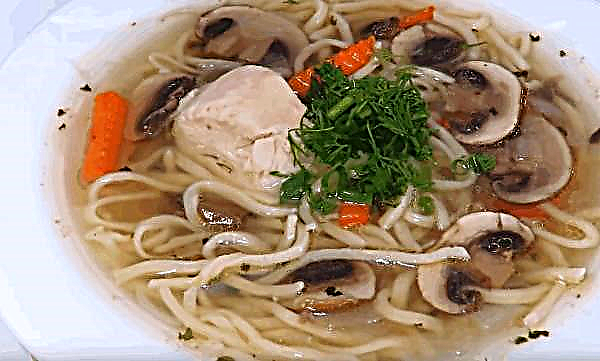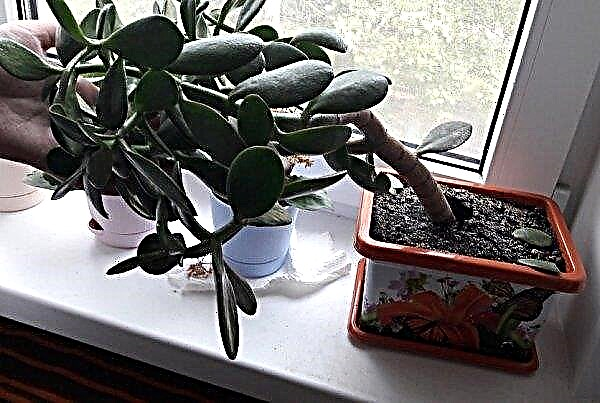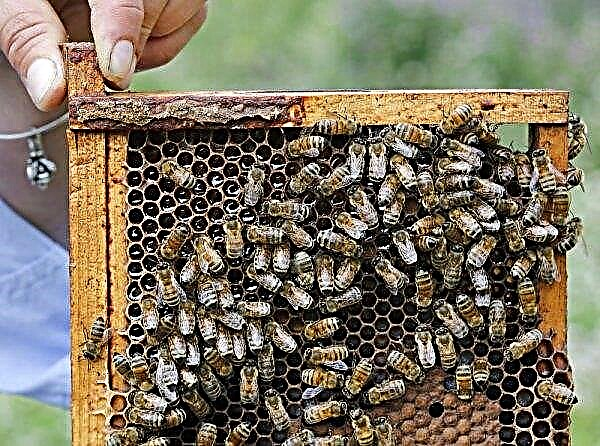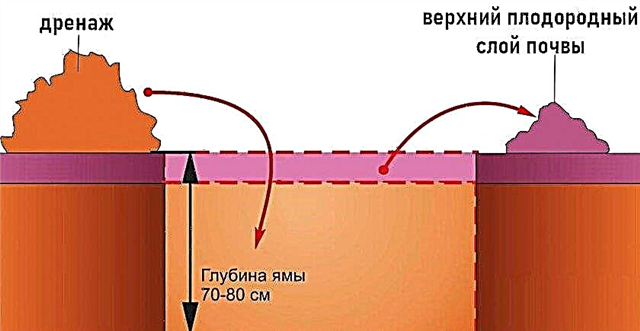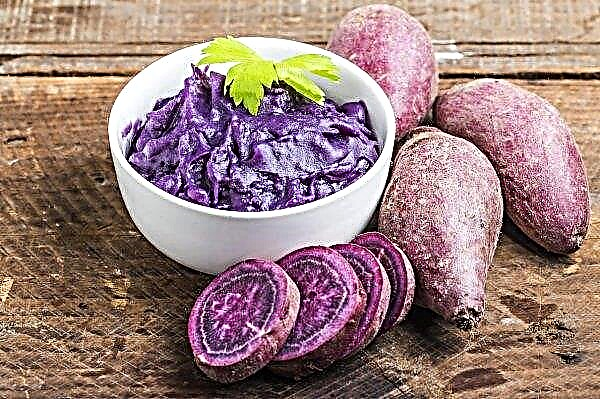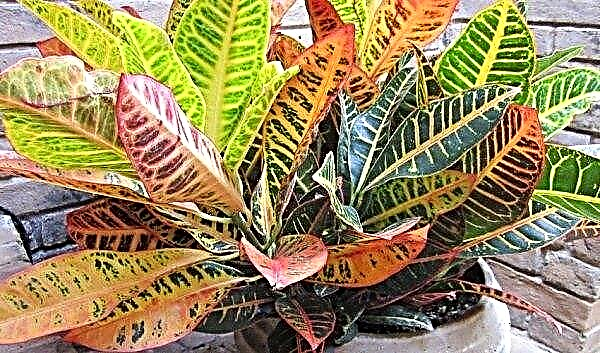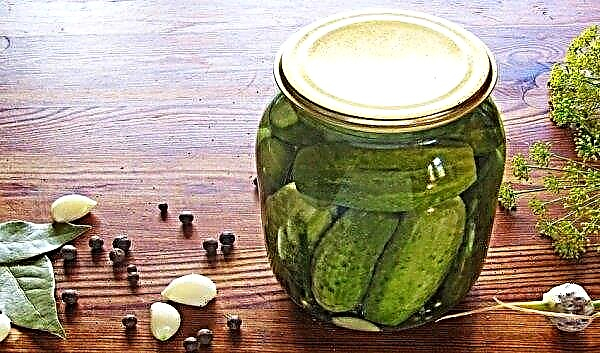Many varieties and hybrids of tomatoes often pose novice gardeners with a difficult choice. From this article we learn the characteristics, strengths and weaknesses of the universal variety “Verlioka”, as well as how to grow seedlings and properly care for plants to get a good harvest.
Grade description
“Verlioka” is an early-ripening universal variety of tomatoes, which is characterized by good productivity and resistance to disease. The taste and presentation of the fruit are good, the tomatoes are fragrant and sweet.
The main characteristics of the variety:
- early ripening variety for greenhouses (in open ground can only be grown in the southern regions), the fruits ripen 90-110 days after planting;
- type of bush - semi-determinant, height - 1.5–2 m;
- medium-sized leaves, green mass is insignificant;
- the shape of the fruit is round, the size is small, the color is bright red;
- the skin of the fruit is quite dense and shiny, the flesh is juicy and watery, the taste is sweet with sourness;
Did you know? The name "tomato" in several languages means apple. In Italian - “golden apple”, in French - “apple of love”, in German - “paradise apple”.
- fruits ripen evenly in small clusters of 5-7 pcs.;
- good presentation;
- universal variety, can be used fresh and for canning;
- the average weight of the fetus is 70–100 g;
- productivity from 1 bush - 4–5 kg;
- requires pinching;
- highly resistant to diseases and pests;
- resistant to adverse weather conditions;
- 3 bushes are recommended to be planted per 1 square meter.

Advantages and disadvantages
"Verlioka" has its advantages and disadvantages, like all tomatoes.
- Advantages:
- early ripeness;
- high productivity;
- marketable condition;
- good taste;
- universality;
- resistance to diseases and temperature changes.
- Disadvantages:
- short shelf life due to the softness of the fruit;
- compulsory bush formation, pinching and garter;
- exactingness to soil.
Self-growing seedlings
For Verliok, a seedling method of growing is suitable. Seedlings can be bought, but not difficult and grow independently from seeds. For successful cultivation, it is necessary to choose the right soil and prepare the seeds, adhere to the timing of sowing. After the emergence of seedlings, proper care of seedlings is necessary.

Sowing dates
Sowing of seeds begins in the second half of March and before the beginning of April. For an early harvest, tomatoes will be optimally sown at the end of February. Early seedlings will have time to well develop the root system and get stronger by the time of planting in a permanent place.
The soil
For growing tomatoes, a nutritious and light soil with neutral or slightly increased acidity is suitable (optimal pH is 6). You can buy ready-made soil or prepare a mixture of peat, humus, sawdust in a ratio of 3: 1: 0.5. It will be a plus to add a small amount of fertilizer superphosphate and wood ash to the soil. You can disinfect the soil by watering with copper sulfate or by calcining in the oven.
Capacity for growing
For growing seedlings, boxes, containers or individual cups are suitable. Special and peat tablets that are sold in stores have become popular and convenient. The use of tablets makes it easy to plant seedlings, the root system is not injured, moreover, such seedlings do not require picking.
Seed preparation
Seeds purchased in the store do not require additional processing, they are already disinfected. If you are planting seeds harvested on your own, it is best to use two years ago. Before sowing, they must be disinfected in a weak solution of potassium permanganate, and then soaked in a growth stimulator for 10 hours.

Sowing seeds
When sowing in containers, the soil is tamped and moistened, the seeds are laid out so that the distance between them is about 3 cm. Then, they are covered with a two-centimeter layer of soil on top, slightly compacted and moistened.
If peat tablets are used, then they are placed in plastic cups and watered. After the contents swell, sow several seeds in each tablet and moisturize.
The containers are covered with film or glass and placed in a dark and warm place (+23 ... + 25 ° C). In a week, the first shoots should appear, and the containers are rearranged closer to sunlight in a cooler place (room temperature).Important! The optimal depth for sowing tomato seeds is 1.5–2 cm.
Seedling Care
Strong seedlings can be grown with proper care.
Its main constituent factors are:
- seat selection
- adequate lighting
- optimal temperature
- timely watering and cultivation,
- top dressing.

The optimum temperature for young tomato sprouts is about +20 ° C. Water in moderation (on average 1 time in 6 days) using a spray gun, always warm water. Excess moisture adversely affects the growth of tomatoes. Loosening the soil is necessary for better oxygen access. The first top dressing of seedlings is preferably done after the appearance of two leaves. Mineral and nitrogen fertilizers are used for top dressing.
If seedlings are grown in boxes, then a pick is needed. A tomato transplant can begin when 2–4 leaves appear. Picked seedlings are fed after 2 weeks. You can use a solution of 1 tbsp. tablespoons nitrofoski in 1 liter of water at room temperature.
Important! In order not to damage the root system, you should moisten the soil well before diving.
Seedling hardening
To strengthen the seedlings, it is necessary to harden it. The procedure begins two weeks before planting in the ground. Tanks with tomatoes are taken out to fresh air, to an open balcony or to the street. The first time - just a few hours, preferably in the evening in good warm weather. Every day, time is gradually increasing.
Sudden changes in temperature must not be allowed; tomatoes do not tolerate cold. When hardening, the air temperature should not fall below +8 ° C, drafts should also be avoided. First, choose a shaded place and gradually accustom to the sun.
As a result, the root system of tomatoes develops well, the stems become thick with short internodes, the color is saturated green with a purple hue. Hardened seedlings adapt more easily after planting in the ground and subsequently give a good harvest.

Planting seedlings in a permanent place
For Verliok, planting in a permanent place in a greenhouse or greenhouse begins at a seedling age of 20–35 days. With proper care during this time, the stalks of tomatoes became thick and strong, several pairs of leaflets formed on them.
The landing site is chosen with good lighting, without shading by other plants, trees or buildings. Tomatoes grow well in the soil, where carrots, legumes, cabbage, dill, parsley were previously grown. It is not recommended to plant tomatoes after solanaceous, potato, sweet pepper and eggplant. Thoroughly prepare the soil, make humus and wood ash, remove weeds and carry out cultivation.
Did you know? Two glasses of tomato juice have a daily intake of vitamin C, and tomatoes also contain serotonin (the “hormone of happiness”), which perfectly cheers you up.
Planting seedlings is carried out in 2 rows with a half-meter row spacing, the distance between the bushes is not less than 40 cm. You can use the chess scheme of planting tomatoes with an interval of about 80 cm. For convenience, it is advisable to leave wide aisles every two rows. After planting, the plants are watered with warm water.
Care Features
Tomatoes in a greenhouse require special care, moderate watering, top dressing and prevention from various diseases. As it grows, it is important to form bushes in time and correctly, to make stepsoning and garter.
Watering
Watering tomatoes should be moderate, but at the same time, drying out the soil should not be allowed. On average, it is carried out every 5-6 days, preferably in the evening. Tomatoes need more water during flowering and fruit growth. When mass ripening of fruits begins, watering should be moderate. Water should be at room temperature. It is best to use irrigation.

To prevent excessive humidity, the greenhouse is ventilated daily. It is advisable to loosen and clean the soil after watering and to remove weeds.
Top dressing
Regular top dressing is essential for successful tomato cultivation. The yield and taste depend on the mineral fertilizers introduced into the soil. The first feeding is carried out two weeks after planting in the greenhouse, superphosphate and wood ash are ideal. Then the procedure is repeated every 2-3 weeks, complex fertilizers are suitable. It is necessary to abandon nitrogen-containing fertilizers during fruit ripening.
Stepson
A properly formed bush is the key to a good tomato crop. Verlioka requires stepsonage. Leave one stem, the others are removed, leaving the shoots several centimeters long. The main stem should be clipped after the appearance of 3-4 brushes with fruits, leaving a few leaves on top of the inflorescence. After that, leave another upper stepson at a convenient height for a larger crop.
Gardeners are advised to remove the lower leaves and greens near the clusters of fruits.

Soil care
Regular soil care consists in timely weeding and loosening for better air access to the root system. Mulching will help preserve moisture and avoid its excessive evaporation.
Bush tying
Bushes “Verlioka” must be tied to supports using a soft rope. You can tie the stems with fabric strips to horizontal bars.
It is convenient to use the trellis method of garter. Strong vertical supports are installed at the beginning and end of the row and several wires are pulled between them at different heights. Another method - one horizontal wire is pulled at a height of 2 m, and vertical twines go down to each bush from it.
This method makes it possible to reliably fix the bush and bunches with fruits, to protect the plant from mechanical damage. A tied bush will not break under the weight of the fruit, it will develop correctly and quickly, it will have access to sunlight and fresh air.
Preventative treatment
With proper care, watering and airing the greenhouse, Verlioka tomatoes rarely get sick. This variety is quite resistant to diseases, temperature extremes and tolerates a lack of sunlight. If in the process of growing tomatoes a number of mistakes were made, such as excessive watering, poor lighting and too low a temperature, then there is a high probability of tomato damage by disease. "Verlioca" is still sensitive to fungal diseases, late blight.
The best prevention against disease is proper care. Disinfecting the soil before planting tomatoes will help prevent many diseases, get rid of pests and increase plant immunity. It is necessary to prepare a solution of 2 g of potassium permanganate in hot (+80 ° С) water of 10 l and tillage in the greenhouse. The solution of Fitosporin in water (15 ml / 10 l) will improve the microflora of the soil and increase the resistance of plants to diseases.

Dosed watering and regular ventilation of the greenhouse will be a prevention against fungal diseases. But young, fragile seedlings can be affected by the "black leg". A good preventive measure against this disease is wood ash, introduced into the soil before transplanting seedlings. Sprinkling tomatoes with ash will also help from the top rot of fruits. Spraying bushes with copper-containing preparations (vitriol, Bordeaux fluid) will help against late blight.
The enemies of tomatoes are slugs, aphids, Colorado potato beetles, thrips. In the fight against them, folk methods will help: strong solutions of garlic, onion husks, tobacco, soap. If natural remedies did not cope with the problem, then you have to resort to complex insecticides.
Video: Tomato varieties "Verlioka"
So, we got acquainted with the characteristics of the Verlioka tomato variety. The variety is suitable for growing in greenhouses both for professional gardeners for commercial purposes, and for amateurs and beginners for their own family. Verlioca with proper care will provide a good harvest. Fresh, juicy tomatoes will be not only all summer, if you wish, you can also make preparations for the winter.


